Dying on the Job: Wyoming Occupational Fatalities, 2003-2005
Occupational fatalities claimed an average of 38 workers’ lives per year from 1993 to 2005. An aggregation of data for 2003-2005 reveals that half of all workplace fatalities were investigated by the Wyoming Highway Patrol; the Occupational Safety & Health Administration had authority over nearly one-quarter. Transportation accidents, and highway accidents in particular, represent a significant threat to worker safety in Wyoming and the nation. By combining data, common accident themes are revealed, which ultimately may lead to successful prevention strategies.
In a typical year, approximately 1 percent of deaths in Wyoming occur while individuals are at work (see Table 1). Wyoming occupational fatalities steadily increased from 2003 to 2005, reaching a record number of 46 in 2005 (see Figure), before declining to 36 in 2006. In this article we combine data for 2003 to 2005 to help gain a better understanding of occupational fatalities in the state. We describe fatalities on the basis of agency investigative authority (e.g., Occupational Safety & Health Administration, local police), demographics, occupation and industry, fatalities by state of residence, and transportation accidents.
Investigative AuthorityTable 2 shows Wyoming occupational fatalities on the basis of which agencies have the authority to investigate the cause of death. Investigative authority was determined from the source documents used to describe the fatalities.
Although the Occupational Safety & Health Administration (OSHA) is generally viewed as the overseer of workplace safety, its statutory authority over occupational fatalities is limited (U.S. Department of Labor, Occupational Safety & Health Administration, 2005). Of the 126 fatalities from 2003-2005, only 23.8% (30 deaths) were investigated by OSHA because of statutory and regulatory guidelines.
In Wyoming and most other states, a significant limitation to OSHA’s authority is that it does not investigate work-related transportation accidents. From 2003-2005, 79 deaths (62.7%) involved transportation accidents. Modes of transportation included, but were not limited to, motor vehicles, aircraft, and trains. The Wyoming Highway Patrol had investigative oversight of the vast majority of transportation-related fatalities (63). Another 7 transportation deaths were investigated by the National Transportation Safety Board (NTSB). The remaining 9 transportation fatalities were investigated by various other agencies (e.g., local police).
OSHA also is limited in its authority to investigate agricultural accidents. By law, only agricultural firms that employ 11 or more workers are overseen by OSHA. Consequently, unlike industries such as Mining, the 7 accidental deaths in agriculture were only investigated by a coroner or similar authority.
DemographicsTables 3 and 4 show Wyoming occupational fatalities by gender and age group, respectively. Most workers who died on the job were male; only 11 (8.7%) of the 126 workers who died from 2003 to 2005 were female.
Fatalities were more evenly distributed by age than by gender. The largest number occurred among individuals 45-54 years old (30 fatalities), while the fewest involved those 65 and older (9 deaths). The percentage of workers age 45-54 who died on the job (23.8%) was slightly higher than the estimated proportion of individuals in the same age group in the state population (21.4%).
Occupation and IndustryTable 5 shows the largest number of deaths by major occupation group occurred in construction & extraction occupations (40 deaths; 31.7%). Deaths in this occupational group were nearly evenly divided between construction & extraction occupations (19 and 21 deaths, respectively). Fatalities can occur by means of any event, including highway accidents.
Truck drivers, heavy & tractor-trailer, incurred the most fatalities for individual occupations (25 deaths, or 19.8%). The majority of deaths were a result of highway accidents. Out-of-state truck drivers crossing the state on the major arterial roads (e.g., Interstate 80) often were the victims.
Among industry sectors, Transportation & Warehousing experienced the largest number of deaths (31, or 24.6%), with 21 occurring in truck transportation (see Table 6).
Nearly one-fourth of deaths (29, or 23.0%) were workers employed in the Mining industry. The bulk of fatalities occurred in support activities for mining (19); 11 were employed in support activities for oil & gas operations.
State of ResidenceMore than one-third of all workplace deaths (49 fatalities, or 38.9%) occurred to nonresidents (see Table 7). Residency is usually established by a death certificate. Residents of states surrounding Wyoming were the most frequent nonresident fatalities. Nebraska was the only neighboring state with no occupational fatalities in Wyoming from 2003-2005. Colorado and South Dakota residents experienced the largest number of fatalities in Wyoming (12 and 8 deaths, respectively). Four individuals from Idaho and three individuals from Utah died while on the job in Wyoming. Four deaths occurred to Texas residents (3.2%). From 2003 to 2005, an estimated 2,000 to 3,750 Texans worked in Wyoming in a given quarter, or approximately 5% of nonresident workers (Leonard, 2007). The remaining 18 nonresident deaths came from other states.
Transportation AccidentsA significant number of work-related deaths occur each year because of transportation accidents. Table 8 shows that 79 of the 126 work-related deaths from 2003 to 2005 were the result of transportation accidents. Of those, 41.8% were workers employed in transportation & material moving occupations, the most of any major occupation group. Many of these individuals worked as truck drivers.
In construction & extraction, 19 of 40 deaths were due to transportation accidents. Transportation accidents caused all but 1 of the 7 deaths in management occupations.
A total of 38 Wyoming residents died as a result of transportation accidents, or 30.2% of total fatalities from 2003 to 2005. While nonresidents made up 38.9% of all deaths, more than half of all work-related transportation fatalities were nonresidents (51.9%).
Of all fatality events, deaths on the state’s highways annually ranged from 24.1% of occupational fatalities in 1997 to 58.1% of deaths in 2004 (see Table 9). However, as a percentage of total highway fatalities, work-related deaths represented a significantly lower share. In 2004, when work-related highway accidents were at their highest, occupational fatalities on the state’s highways represented 15.2% of all highway fatalities.
SummaryOccupational fatalities in Wyoming steadily rose from 2003 to 2005. Despite the increases, work-related accidents in the state constituted approximately 1 percent of all deaths each year. Half of all accidents were investigated by the Wyoming Highway Patrol; OSHA had investigative authority over approximately one-fourth. Most victims of workplace fatalities were men, and fatalities by age were fairly evenly distributed. The number of deaths in transportation & material moving and construction & extraction occupations was higher than for other occupations, while workplace deaths in the Mining and Transportation & Warehousing industries were higher than in other industries. Colorado residents were the most frequent nonresident victims. Transportation accidents, in particular, claimed the most nonresidents.
ReferencesLeonard, D. (2007, August). Inflow by State of Origin for Workers with Out-of-State Driver’s Licenses, 2001Q1-2005Q4 [unpublished tables]. Wyoming Department of Employment, Research & Planning.
U.S. Department of Labor, Occupational Safety & Health Administration. (2005, March 18). Laws, Regulations and Interpretations. Retrieved August 2, 2007, from http://www.osha.gov/comp-links.html
Return to text
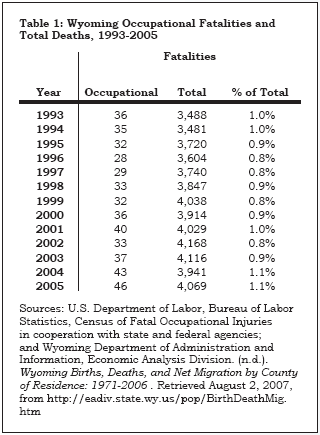
Return to text

Return to text

Return to text
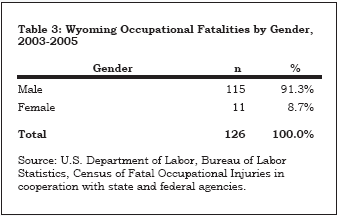
Return to text
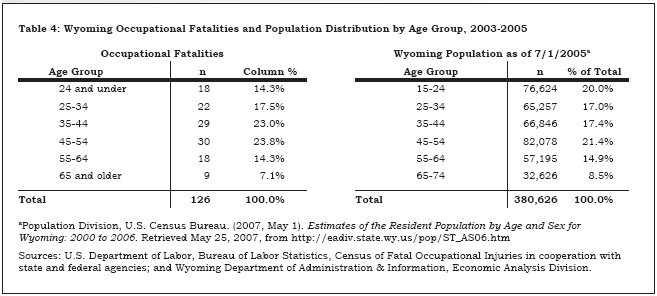
Return to text
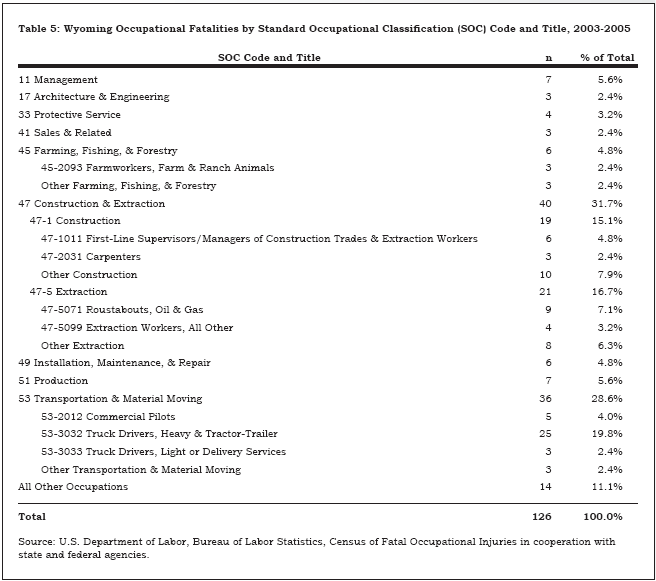
Return to text
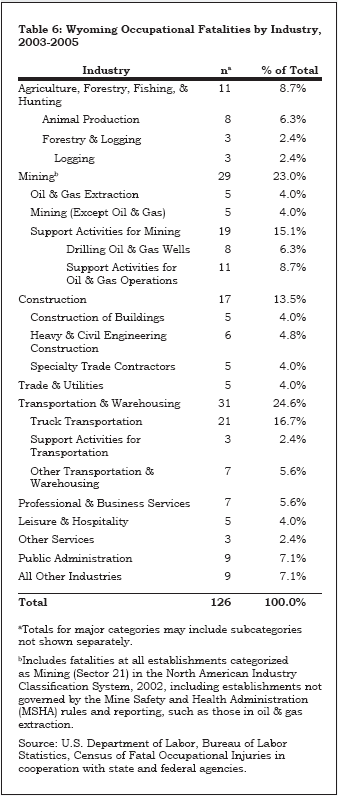
Return to text
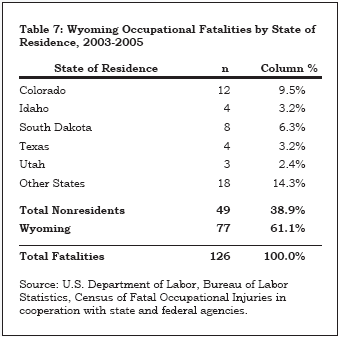
Return to text

Return to text

Last modified on
by April Szuch.
